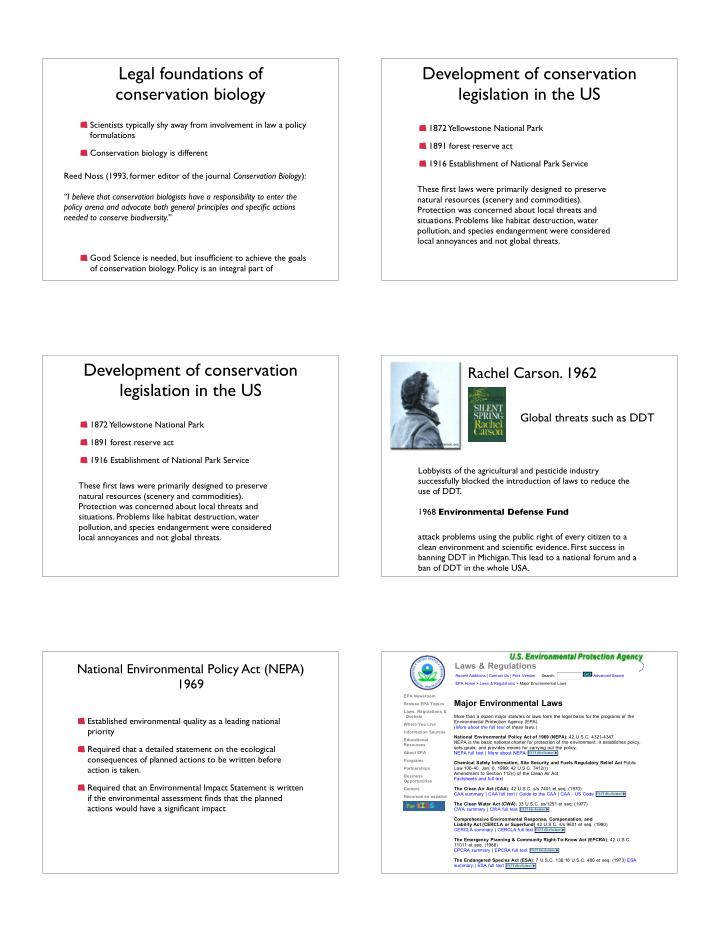



Legal foundations of Development of conservation conservation biology legislation in the US Scientists typically shy away from involvement in law a policy 1872 Yellowstone National Park formulations 1891 forest reserve act Conservation biology is different 1916 Establishment of National Park Service Reed Noss (1993, former editor of the journal Conservation Biology ): These first laws were primarily designed to preserve “I believe that conservation biologists have a responsibility to enter the natural resources (scenery and commodities). policy arena and advocate both general principles and specific actions Protection was concerned about local threats and needed to conserve biodiversity.” situations. Problems like habitat destruction, water pollution, and species endangerment were considered local annoyances and not global threats. Good Science is needed, but insufficient to achieve the goals of conservation biology. Policy is an integral part of Development of conservation Rachel Carson. 1962 legislation in the US Global threats such as DDT 1872 Yellowstone National Park 1891 forest reserve act 1916 Establishment of National Park Service Lobbyists of the agricultural and pesticide industry successfully blocked the introduction of laws to reduce the These first laws were primarily designed to preserve use of DDT. natural resources (scenery and commodities). Protection was concerned about local threats and 1968 Environmental Defense Fund situations. Problems like habitat destruction, water pollution, and species endangerment were considered attack problems using the public right of every citizen to a local annoyances and not global threats. clean environment and scientific evidence. First success in banning DDT in Michigan. This lead to a national forum and a ban of DDT in the whole USA. National Environmental Policy Act (NEPA) Laws & Regulations Recent Additions | Contact Us | Print Version Search: Advanced Search 1969 EPA Home > Laws & Regulations > Major Environmental Laws EPA Newsroom Major Environmental Laws Browse EPA Topics Laws, Regulations & More than a dozen major statutes or laws form the legal basis for the programs of the Dockets Established environmental quality as a leading national Environmental Protection Agency (EPA). Where You Live ( More about the full text of these laws. ) priority Information Sources National Environmental Policy Act of 1969 (NEPA) ; 42 U.S.C. 4321-4347 Educational NEPA is the basic national charter for protection of the environment. It establishes policy, Resources Required that a detailed statement on the ecological sets goals, and provides means for carrying out the policy. About EPA NEPA full text | More about NEPA consequences of planned actions to be written before Programs Chemical Safety Information, Site Security and Fuels Regulatory Relief Act Public action is taken. Partnerships Law 106-40, Jan. 6, 1999; 42 U.S.C. 7412(r) Amendment to Section 112(r) of the Clean Air Act Business Factsheets and full text Opportunities Required that an Environmental Impact Statement is written Careers The Clean Air Act (CAA) ; 42 U.S.C. s/s 7401 et seq. (1970) CAA summary | CAA full text | Guide to the CAA | CAA - US Code if the environmental assessment finds that the planned Recursos en español The Clean Water Act (CWA) ; 33 U.S.C. ss/1251 et seq. (1977) actions would have a significant impact CWA summary | CWA full text Comprehensive Environmental Response, Compensation, and Liability Act (CERCLA or Superfund) 42 U.S.C. s/s 9601 et seq. (1980) CERCLA summary | CERCLA full text The Emergency Planning & Community Right-To-Know Act (EPCRA) ; 42 U.S.C. 11011 et seq. (1986) EPCRA summary | EPCRA full text The Endangered Species Act (ESA) ; 7 U.S.C. 136;16 U.S.C. 460 et seq. (1973) ESA summary | ESA full text
National Environment Policy Act NEPA: detailed statement (NEPA) environmental impact of the proposed action any adverse action that cannot be avoided Lynton K. Caldwell drafted the law for NEPA: he demanded that a detailed statement must accompany “proposals for alternatives to the proposed action legislation and other major federal actions significantly affecting the quality of the human environment.” relationship between local/short-term use of the environment and long-term use and protection of the The wording was positive and vague, and passed easily house environment. and senate in 1969 and was signed into law 1970 by Nixon. irreversible commitments of resources in case the action is The “detailed statement” on the ecological consequences of implemented. the action became the “teeth” the statement must be circulated among governmental agencies and the public (Non-governmental organizations, libraries, and private citizen groups) A federal action takes place on Shortcomings of NEPA federal land (1/3 of the US) or Decision of on private or state land that planning an needs a federal permit. action NEPA uses as a unit the ecosystem, at the time it was categorically excluded drafted not much research on ecosystem management was EA: Environmental (maintenance actions, Assessment done, which results in a procedural problem: repairs, etc.) a single agency is in control of the EIS FONSI: Other stakeholders have a voice (but it is one way), the draft ? finding of no EIS can be disputed, discussed (, and corrected) significant impact Once a final EIS is drafted only litigation can change it. This diverts energy and money from non-governmental EIS:Environmental Groups Impact Statement organizations and agencies: scientists spend less time in the unsatisfied with FONSI field because the work needs to be litigation proof, .... can ask for court action Endangered species act Clean air/water acts See special lecture Air (1970) Influential in many ways: protection of large areas, EPA sets air quality standards polarization of stakeholders Regulates industrial pollution: pollution permits Water (1972) aspired to attain zero discharge of pollutants permit system and sets limits to tolerable pollution discharge
Recommend
More recommend